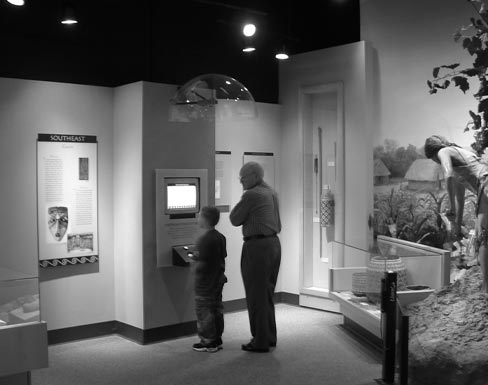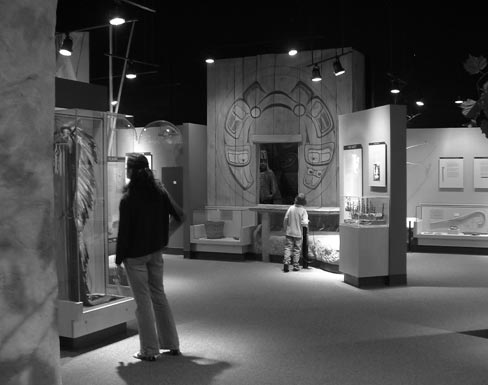Exhibit Review
The Henry Hall of the American Indian
Schiele Museum of Natural History and Planetarium, Gastonia, NC. Curators: Steve Watts, Missy Turney, Ann Tippitt, and Alan May
Permanent exhibit
Since the Schiele Museum of Natural History was established in 1961, it has been a steward of Native American material culture. Founders Bud and Lilly Schiele donated agricultural tools, jewelry, and other items from Native groups across the country to form the basis of the museum's collections. During the late 1970s to late 1980s, the Schiele Museum, located in Gastonia, North Carolina, sponsored southeastern Native American heritage festivals. Currently, the museum conducts ethnographic research with the local Catawba tribe as a part of its ongoing relationship with the Native American community. Residing in 1,600 square feet of gallery space within the museum, the Henry Hall of the American Indian builds on the Schiele Museum's commitment to Native American cultural heritage.
Named for James Henry, the son of long-time patron, Mrs. Dougie Henry, the Henry Hall of the American Indian provides a glimpse of the diversity of Native American cultures. The curators chose to focus on two cultures from each of the five major sections of North America: Southeast (Cherokee and Calusa); Northeast (Seneca and Adawa); Southwest (Hopi and Apache); Plains (Lakota and Hidatsa); and Far West (Tlingit and Paiute). Artifacts displayed throughout the exhibit represent other Native cultures as well.
Opened in 2001, the Henry Hall distinguishes itself from traditional American Indian ethnographic exhibits because it presents Native American perspectives. Contact with explorers and traders, who provided the earliest historical reports on Native Americans, had an impact on those cultures. The Henry Hall exhibit illuminates these facts, but also addresses a more fundamental issue. Native American views of nature and society differ from views of their European and American counterparts. Those differences are not due solely to technology, but are based on different worldviews and, therefore, yield different historical messages. To address these issues, a Native American Advisory Committee helped the museum to develop mutually acceptable policies and procedures for collections, exhibitions, and programs.
The Henry Hall features objects that illustrate Native cultures' unique and ongoing economic, social, and spiritual connections with the land and water. Artifacts, architectural models, and dioramas illustrate the diversity of lifeways of Native Americans throughout the country. The exhibit demonstrates to visitors that in every ecological region of the continent, American Indians developed different and dynamic cultural technologies and these changed in response to social and environmental change. Items such as Tlingit bentwood boxes, on loan from of the Alaska State Museum, and eastern Cherokee baskets from the museum's ethnographic collections provide two examples.
 |
Two visitors use the interactive touch screens to access information on Southeast American Indian culture. (Courtesy of the Schiele Museum of Natural History.) |
Tlingit artisans created bentwood boxes using the centuries-old technique of bending cedar planks with steam and relief cuts and sewing the ends together to create the four sides of the box. A top and bottom are fashioned to finish the box. They range in size from one quart to 50 gallons, were used to transport foodstuffs or luxury items, and provide storage. Artisans painted some with sacred symbols to protect the contents. The tradition has been revived among northwestern Native Americans, who are connected through the practice of their craft with their ancestors.
Similarly, the Cherokee basketry tradition dates back more than 500 years. The Cherokee baskets are woven of rivercane, white oak, and hickory bark. The baskets were used to store household items, hold fishing and hunting supplies, and gather foodstuffs, and were frequently traded with the surrounding settler community. They vary in size and style, from small "market" baskets to double-walled "coffin" varieties, and are dyed with pigments from indigenous plants. The tradition adapted new materials as it traveled with the Cherokee from the southeastern states on the Trail of Tears to Oklahoma. The two examples on exhibit illustrate how ecology and geography created distinct artisan traditions to address similar needs.
Other exhibited objects include an Algonquian style birchbark canoe, Hopi jewelry, Calusa tools on loan from the Florida State Museum, and Arikara Indian pottery on loan from the Carnegie Museum of Natural History. Dioramas or scale miniatures depicting Native community life place objects within the context of their environments. In addition to traditional curatorial presentations, each regional exhibit module contains Encounter Panels that provide interactive touch screens with video presentations on Native American language and music.
Visitors will leave the Schiele Museum's Henry Hall of the American Indian with an increased knowledge and appreciation of the people and the diverse societies that shaped our nation's past. Because the exhibit is not artifact-heavy, the exhibits do not divert attention to objects rather than the people who made them. Preservation professionals will find a wealth of ethnographic material regarding Native Americans in the Henry Hall, making it a worthy addition to the Schiele Museum.
Jefferson Chapman
University of Tennessee

